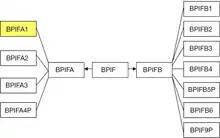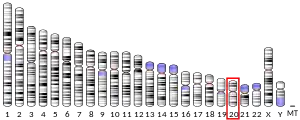BPIFA1
BPI fold containing family A, member 1 (BPIFA1), also known as Palate, lung, and nasal epithelium clone (PLUNC),[5] is a protein that in humans is encoded by the BPIFA1 gene.[6][7] It was also formerly known as "Secretory protein in upper respiratory tracts" (SPURT). The BPIFA1 gene sequence predicts 4 transcripts (splice variants); 3 mRNA variants have been well characterized. The resulting BPIFA1 is a secreted protein, expressed at very high levels in mucosa of the airways (olfactory and respiratory and epithelium) and salivary glands; at high levels in oropharyneal epithelium, including tongue and tonsils; and at moderate levels many other tissue types and glands including pituitary, testis, lung, bladder, blood, prostate, pancreas, levels in the digestive tract (tongue, stomach, intestinal epithelium) and pancreas.[8] The protein can be detected on the apical side of epithelial cells and in airway surface liquid, nasal mucus, and sputum.[9]
Superfamily
BPIFA1 is a member of a BPI fold protein superfamily defined by the presence of the bactericidal/permeability-increasing protein fold (BPI fold) which is formed by two similar domains in a "boomerang" shape.[10] This superfamily is also known as the BPI/LBP/PLUNC family or the BPI/LPB/CETP family.[11] The BPI fold creates apolar binding pockets that can interact with hydrophobic and amphipathic molecules, such as the acyl carbon chains of lipopolysaccharide found on Gram-negative bacteria, but members of this family may have many other functions.

Genes for the BPI/LBP/PLUNC superfamily are found in all vertebrate species, including distant homologs in non-vertebrate species such as insects, mollusks, and roundworms.[12][13] Within that broad grouping is the BPIF gene family whose members encode the BPI fold structural motif and are found clustered on a single chromosome, e.g., Chromosome 20 in humans, Chromosome 2 in mouse, Chromosome 3 in rat, Chromosome 17 in pig, Chromosome 13 in cow. The BPIF gene family is split into two groupings, BPIFA and BPIFB. In humans, BIPFA consists of 3 protein encoding genes BPIFA1, BPIFA2, BPIFA3, and 1 pseudogene BPIFA4P; while BPIFB consists of 5 protein encoding genes BPIFB1, BPIFB2, BPIFB3, BPIFB4, BPIFB6 and 2 pseudogenes BPIFB5P, BPIFB9P. What appears as pseudogenes in humans may appear as fully functional genes in other species.
In humans, the BPIFA1 gene was first identified as an ortholog of the mouse Plunc gene[7] which had earlier been identified from a differential display screen of the embryonic mouse palate.[14] Subsequently, using microarray analysis techniques of human epithelial tissues, the SPURT gene and, separately, the SPLUNC1 gene were identified.[15][16] These were all recognized to be, in fact, the same gene within the BPI/LBP/PLUNC family.
Function
BPIFA1 has multiple functions but perhaps its most prominent ones are related to BPIFA1's localization in nasal, olfactory, oral, and respiratory epithelium and the mucous/fluids that coat them. BPIFA1/SPLUNC1 binds with high affinity and specificity to dipalmitoylphosphatidylcholine, one of the major and most important surfactant phospholipids in the airway and lungs.[17] By lowering the surface tension in mucosal fluids, BPIFA1/SPLUNC1 inhibits bacteria like Klebsiella from proliferating as a biofilm on epithelium.[18] The protein physically interacts with pathogens, causing "bacterial cell coating" that inhibits the epithelial sodium channel of bacteria, makes bacteria like Pseudomonas more permeable, and attracts macrophages and neutrophils for a bactericidal effect. [19][20] As such, BPIFA1 plays a role in innate immune defense in the airways.
BPIFA1/PLUNC's ability to regulate ENaC is pH-sensitive and fails in acidic cystic fibrosis airways.[21] Thus, defective BPIFA1/PLUNC1 gene function is thought to contribute to the development of lung pathology in cystic fibrosis patients.
It may also serve as a potential molecular marker for detection of micrometastasis in non-small-cell lung cancer.[22]
References
- GRCh38: Ensembl release 89: ENSG00000198183 - Ensembl, May 2017
- GRCm38: Ensembl release 89: ENSMUSG00000027483 - Ensembl, May 2017
- "Human PubMed Reference:". National Center for Biotechnology Information, U.S. National Library of Medicine.
- "Mouse PubMed Reference:". National Center for Biotechnology Information, U.S. National Library of Medicine.
- Ghafouri, B. (2003). "PLUNC (palate, lung and nasal epithelial clone) proteins in human nasal lavage fluid". Biochem Soc Trans. 31 (4): 810–4. doi:10.1042/bst0310810. PMID 12887311.
- "BPIFA1 BPI fold containing family A member 1 [Homo sapiens (human)] - Gene - NCBI". www.ncbi.nlm.nih.gov.
- Bingle CD, Bingle L (Oct 2000). "Characterisation of the human plunc gene, a gene product with an upper airways and nasopharyngeal restricted expression pattern". Biochimica et Biophysica Acta (BBA) - Gene Structure and Expression. 1493 (3): 363–7. doi:10.1016/S0167-4781(00)00196-2. PMID 11018263.
- "Gene : BPIFA1 - ENSG00000198183". bgee.org. The Bgee suite: integrated curated expression atlas and comparative transcriptomics in animals.
- "Q9NP55 - BPIA1_HUMAN". www.uniprot.org.
- Beamer LJ, Carroll SF, Eisenberg D (April 1998). "The BPI/LBP family of proteins: a structural analysis of conserved regions". Protein Science. 7 (4): 906–914. doi:10.1002/pro.5560070408. PMC 2143972. PMID 9568897.
- "CDD Conserved Protein Domain Family: BPI". www.ncbi.nlm.nih.gov.
- Beamer LJ, Fischer D, Eisenberg D (July 1998). "Detecting distant relatives of mammalian LPS-binding and lipid transport proteins". Protein Science. 7 (7): 1643–1646. doi:10.1002/pro.5560070721. PMC 2144061. PMID 9684900.
- Bingle CD, Seal RL, Craven CJ (August 2011). "Systematic nomenclature for the PLUNC/PSP/BSP30/SMGB proteins as a subfamily of the BPI fold-containing superfamily". Biochemical Society Transactions. 39 (4): 977–983. doi:10.1042/BST0390977. PMC 3196848. PMID 21787333.
- Weston WM, LeClair EE, Trzyna W, McHugh LM, Nugent P, Lafferty CM, Ma LL, Tuan RS, Greene RM (May 1999). "Differential Display Identification of plunc, a Novel Gene Expressed in Embryonic Palate, Nasal Epithelium, and Adult Lung". Journal of Biological Chemistry. 274 (19): 13698–13703. doi:10.1074/jbc.274.19.13698. PMID 10224143.
- Di YP, Harper R, Zhao Y, Pahlavan N, Finkbeiner W, Wu R (January 2003). "Molecular Cloning and Characterization of spurt, a Human Novel Gene That Is Retinoic Acid-inducible and Encodes a Secretory Protein Specific in Upper Respiratory Tracts". Journal of Biological Chemistry. 278 (2): 1165–1173. doi:10.1074/jbc.M210523200. PMID 12409287.
- Zhang B, Nie X, Xiao B, Xiang J, Shen S, Gong J, et al. (September 2003). "Identification of tissue-specific genes in nasopharyngeal epithelial tissue and differentially expressed genes in nasopharyngeal carcinoma by suppression subtractive hybridization and cDNA microarray". Genes, Chromosomes and Cancer. 38 (1): 80–90. doi:10.1002/gcc.10247. PMID 12874788. S2CID 24805514.
- Ning F, Wang C, Berry KZ, Kandasamy P, Liu H, Murphy RC, et al. (December 2014). "Structural characterization of the pulmonary innate immune protein SPLUNC1 and identification of lipid ligands". The FASEB Journal. 28 (12): 5349–5360. doi:10.1096/fj.14-259291. PMC 4232288. PMID 25223608.
- Liu Y, Bartlett JA, Di ME, BombergerJM, Chan YR, GakharL, et al. (May 2013). "SPLUNC1/BPIFA1 Contributes to Pulmonary Host Defense against Klebsiella pneumoniae Respiratory Infection". The American Journal of Pathology. 182 (5): 1519–1531. doi:10.1016/j.ajpath.2013.01.050. PMC 3644735. PMID 23499554.
- Garcia-Caballero A, Rasmussen JE, Gaillard E, Watson MJ, Olsen JC, Donaldson SH, Stutts MJ, Tarran R (Jul 2009). "SPLUNC1 regulates airway surface liquid volume by protecting ENaC from proteolytic cleavage". Proceedings of the National Academy of Sciences of the United States of America. 106 (27): 11412–7. Bibcode:2009PNAS..10611412G. doi:10.1073/pnas.0903609106. PMC 2708735. PMID 19541605.
- Sayeed S, Nistico L, St Croix C, Di YP, et al. (January 2013). "Multifunctional Role of Human SPLUNC1 in Pseudomonas aeruginosa Infection". Infection and Immunity. 81 (1): 285–291. doi:10.1128/IAI.00500-12. PMC 3536124. PMID 23132494.
- Garland AL, Walton WG, Coakley RD, Tan CD, Gilmore RC, Hobbs CA, Tripathy A, Clunes LA, Bencharit S, Stutts MJ, Betts L, Redinbo MR, Tarran R (Oct 2013). "Molecular basis for pH-dependent mucosal dehydration in cystic fibrosis airways". Proceedings of the National Academy of Sciences of the United States of America. 110 (40): 15973–8. Bibcode:2013PNAS..11015973G. doi:10.1073/pnas.1311999110. PMC 3791714. PMID 24043776.
- "Entrez Gene: PLUNC".
Further reading
- Garcia-Caballero A, Rasmussen JE, Gaillard E, Watson MJ, Olsen JC, Donaldson SH, Stutts MJ, Tarran R (Jul 2009). "SPLUNC1 regulates airway surface liquid volume by protecting ENaC from proteolytic cleavage". Proceedings of the National Academy of Sciences of the United States of America. 106 (27): 11412–7. Bibcode:2009PNAS..10611412G. doi:10.1073/pnas.0903609106. PMC 2708735. PMID 19541605.
- Zhang BC, Zhu SG, Xiang JJ, Zhou M, Nie XM, Xiao BY, Li XL, Li GY (May 2003). "[Analysis of splicing variants in NASG 3'UTR, down-regulated in nasopharyngeal carcinoma, and its expression in multiple cancer tissues]". AI Zheng = Aizheng = Chinese Journal of Cancer. 22 (5): 477–80. PMID 12753706.
- Dagle JM, Lepp NT, Cooper ME, Schaa KL, Kelsey KJ, Orr KL, Caprau D, Zimmerman CR, Steffen KM, Johnson KJ, Marazita ML, Murray JC (Apr 2009). "Determination of genetic predisposition to patent ductus arteriosus in preterm infants". Pediatrics. 123 (4): 1116–23. doi:10.1542/peds.2008-0313. PMC 2734952. PMID 19336370.
- Bryborn M, Halldén C, Säll T, Cardell LO (Feb 2010). "CLC- a novel susceptibility gene for allergic rhinitis?". Allergy. 65 (2): 220–8. doi:10.1111/j.1398-9995.2009.02141.x. PMID 19650845. S2CID 29636426.
- Cheng M, Chen Y, Yu X, Tian Z, Wei H (2008). "Diagnostic utility of LunX mRNA in peripheral blood and pleural fluid in patients with primary non-small cell lung cancer". BMC Cancer. 8: 156. doi:10.1186/1471-2407-8-156. PMC 2424066. PMID 18513434.
- Zhou HD, Li GY, Yang YX, Li XL, Sheng SR, Zhang WL, Zhao J (Apr 2006). "Intracellular co-localization of SPLUNC1 protein with nanobacteria in nasopharyngeal carcinoma epithelia HNE1 cells depended on the bactericidal permeability increasing protein domain". Molecular Immunology. 43 (11): 1864–71. doi:10.1016/j.molimm.2005.10.021. PMID 16364440.
- Lim J, Hao T, Shaw C, Patel AJ, Szabó G, Rual JF, Fisk CJ, Li N, Smolyar A, Hill DE, Barabási AL, Vidal M, Zoghbi HY (May 2006). "A protein-protein interaction network for human inherited ataxias and disorders of Purkinje cell degeneration". Cell. 125 (4): 801–14. doi:10.1016/j.cell.2006.03.032. PMID 16713569. S2CID 13709685.
- Zhou HD, Fan SQ, Zhao J, Huang DH, Zhou M, Liu HY, Zeng ZY, Yang YX, Huang H, Li XL, Shen SR, Li GY (Mar 2006). "Tissue distribution of the secretory protein, SPLUNC1, in the human fetus". Histochemistry and Cell Biology. 125 (3): 315–24. doi:10.1007/s00418-005-0070-4. PMID 16195890. S2CID 20600762.
- Sentani K, Oue N, Sakamoto N, Arihiro K, Aoyagi K, Sasaki H, Yasui W (Apr 2008). "Gene expression profiling with microarray and SAGE identifies PLUNC as a marker for hepatoid adenocarcinoma of the stomach". Modern Pathology. 21 (4): 464–75. doi:10.1038/modpathol.3801050. PMID 18204429.
- Campos MA, Abreu AR, Nlend MC, Cobas MA, Conner GE, Whitney PL (Feb 2004). "Purification and characterization of PLUNC from human tracheobronchial secretions". American Journal of Respiratory Cell and Molecular Biology. 30 (2): 184–92. doi:10.1165/rcmb.2003-0142OC. PMID 12920053.
- He Y, Ding YQ, Huang ZX, Yao KT (Jun 2007). "[Association of the coding region single nucleotide polymorphisms in PLUNC gene with nasopharyngeal carcinoma]". Zhonghua Yi Xue Za Zhi. 87 (22): 1553–5. PMID 17785110.
- Wang WB, Cui YG, Yao SY (Feb 2008). "[Message RNA expression of LUNX, CK19 and CEA genes in NSCLC with micrometastasis in lymph nodes]". Zhonghua Zhong Liu Za Zhi [Chinese Journal of Oncology]. 30 (2): 121–4. PMID 18646695.
- Bartlett JA, Hicks BJ, Schlomann JM, Ramachandran S, Nauseef WM, McCray PB (May 2008). "PLUNC is a secreted product of neutrophil granules". Journal of Leukocyte Biology. 83 (5): 1201–6. doi:10.1189/jlb.0507302. PMID 18245229. S2CID 19196781.
- Zhou HD, Li XL, Li GY, Zhou M, Liu HY, Yang YX, Deng T, Ma J, Sheng SR (Feb 2008). "Effect of SPLUNC1 protein on the Pseudomonas aeruginosa and Epstein-Barr virus". Molecular and Cellular Biochemistry. 309 (1–2): 191–7. doi:10.1007/s11010-007-9659-3. PMID 18049866. S2CID 23343796.
- Bingle L, Barnes FA, Cross SS, Rassl D, Wallace WA, Campos MA, Bingle CD (2007). "Differential epithelial expression of the putative innate immune molecule SPLUNC1 in cystic fibrosis". Respiratory Research. 8 (1): 79. doi:10.1186/1465-9921-8-79. PMC 2203987. PMID 17988392.
External links
- Human BPIFA1 genome location and BPIFA1 gene details page in the UCSC Genome Browser.
- PLUNC+protein,+human at the U.S. National Library of Medicine Medical Subject Headings (MeSH)



